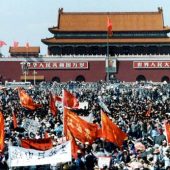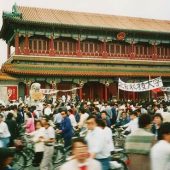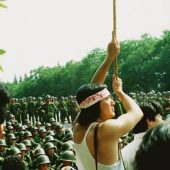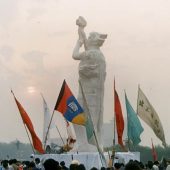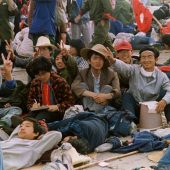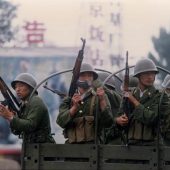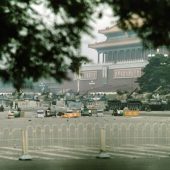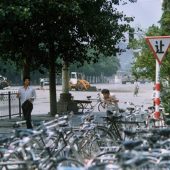Tiananmen Square 30 years ago with the Nikon F-801 is by Terril Jones who shot the fifth view of the “Tank Man”:

Student protesters supporting hunger strikers at Tiananmen Square in mid-May, 1989. Photo by Terril Jones.
Thirty years ago this week I left China after what was intended to be a week-long stay in Beijing had stretched to 59 days. As a reporter for The Associated Press based in Tokyo, I had gone to Beijing to help with the coverage of the state visit to China by Mikhail Gorbachev, leader of the then Soviet Union. But that assignment quickly morphed from covering the historic mending of the three-decade-old Sino-Soviet split to the AP’s 24/7 reporting from Tiananmen Square covering the student-led protests that culminated in the Chinese army’s violent assault on the demonstrators in the square.
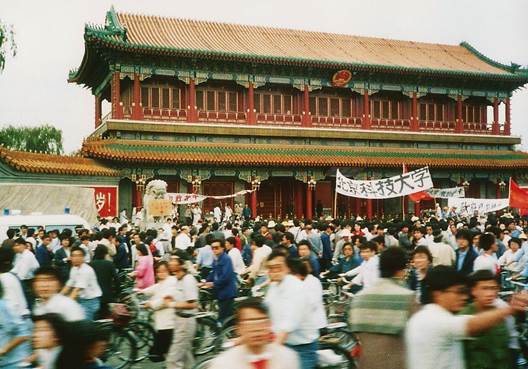
Protesters swirl past the Xinhua Gate on Changan Boulevard, the ceremonial entrance to Zhongnanhai, the Chinese Communist Party compound in mid-May, 1989. Photo by Terril Jones.
The photographs of the man facing down the row of tanks, taken June 5, 1989, the day after the army took back Tiananmen Square amid needless bloodshed, are among the most iconic images of the 20th century. As Nikon Rumors previously noted, the four photographers who took the familiar pictures of the man all used Nikon gear. I also took a photograph that was a fifth view of the man who stopped the tanks, and I too used a Nikon.
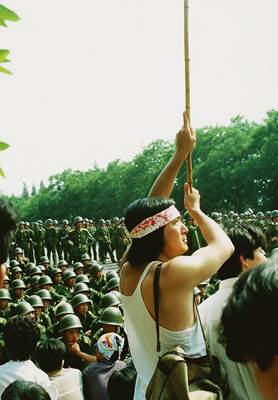
A defiant protester confronting soldiers at the edge of Tiananmen Square June 3, 1989. Photo by Terril Jones.

The Goddess of Democracy statue, built by students from the Central Academy of Fine Arts, assembled in Tiananmen Square in late May, 1989.
I’m a text reporter, not a photojournalist, so I’m not fluent talking about F-mounts or vibration reduction or phase-contrast focusing, but I always carry a camera of some sort, whether an SLR, a point-and-shoot or in recent years a smartphone. While in China in the spring of 1989 I had my Nikon AF F-801 with Nikkor f3.5 28-85mm autofocus lens, and a Nikkor f4.5 80-200 manual focus zoom. I had bought the body and the 28-85 glass from an AP photographer in Japan who was moving on to higher-end hardware, hence my camera, introduced in 1988, was called the F-801; in the U.S. it was known as the N8008. (It was the successor to what I believe was Nikon’s first autofocus SLR, the F-501 — N2020 in the U.S. — of 1986.) Mine was not a particularly versatile lens kit for a photojournalist, but taking pictures was secondary to my reporting.
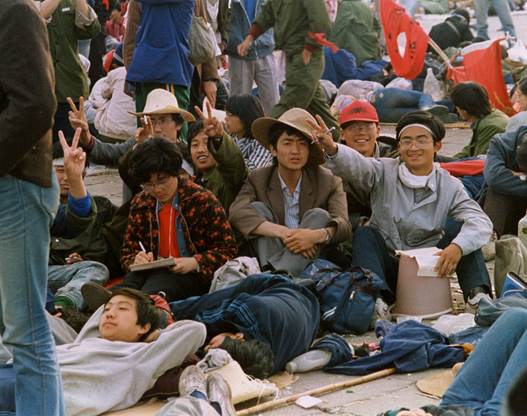
Chinese university students, some on hunger strikes, at Tiananmen Square in mid-May, 1989. Photo by Terril Jones.
Once the hunger strike by Chinese university students started May 13, 1989, I spent my days, and many nights, out on the square and in the streets of Beijing. My mother is Chinese and I learned Mandarin with her at home and from attending eighth grade at a Chinese school in Taiwan. I interviewed students and bystanders, wrote wrapups and sidebars, monitored the news and took photos and video of much of what I saw, including television newscasts straight off the TV screen in the AP bureau. The protests, which broadly speaking sought transparency in governance and social liberalizations, were hardly challenged by Chinese authorities for three weeks. Parades of demonstrators paralyzed the capital and riveted the world, and TV networks broadcast live day and night, as they had secured live satellite links for the Gorbachev visit. The appetite for news and images of the chaos in Beijing was insatiable. With every reporter and photographer having completely different encounters and experiences every day, photo editors sent several of my pictures out on the wire to global subscribers.
Throughout those tumultuous days and nights of Tiananmen coverage, reporters and photographers would head out to the streets, knowing we were covering the biggest story in the world but having no idea what the story each day would be. That is a journalist’s dream.
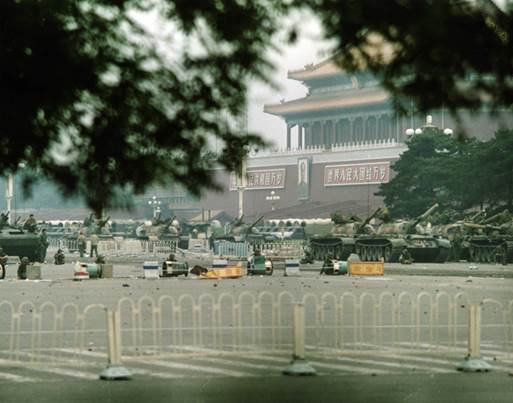
Tanks and soldiers surround the perimeter of Tiananmen Square, June 4, 1989. Photo by Terril Jones/AP.
On June 5, the day after the People’s Liberation Army stormed into Tiananmen Square, leaving at least scores dead, I was standing by the Beijing Hotel, a stone’s throw to the east. I heard tanks revving up (they’re jarringly loud) and gunshots coming from the square. I saw people ducking and running, and lifted my camera to take one shot before taking cover myself. I took an instant to frame the shot with the approaching tanks at the right, and people running away to the left, probably toward the wide end at 28mm. The autofocus worked perfectly in the rush. I then ran into the hotel to get a better view from my 11th-floor room. I took some shots of a long line of tanks snaking out of the square, clearing Changan Boulevard to allow a convoy of army trucks into the square, which had a ridiculously heavily armed perimeter with tanks and soldiers crouching behind barrels like snipers facing the crowds of curious, and outraged, citizens.
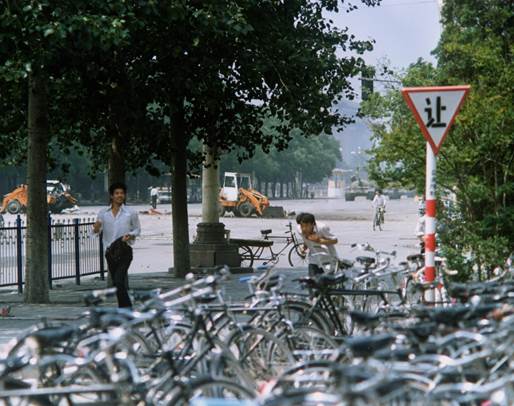
Bystanders flee tanks approaching from Tiananmen Square June 5, 1989. At center left between the trees in the background is the man in the white shirt who stopped the line of tanks in the well-known photos, dubbed “Tank Man.” Photo by Terril Jones/AP.
Only weeks later when I returned to Japan and took time to print the photo as an 8×10 did I notice that I had captured a shot of the man in the white shirt as he waited in the middle of the boulevard for the tanks to approach. He is there long before the tanks got to him, seemingly calm, seemingly determined. He seems to be clearing a path for others in the frame who are running for their lives, but he was gone by the time I reached my hotel room. The world has speculated for 30 years who this man is and what his motivations were, but we will likely never know.
Today in my classes students produce short news videos; they all use their phones. Meanwhile I hanker for a prosumer DSLR with a DX/APS-C sensor that takes good video. If only we’d had those back in 1989.
–
Terril Jones is a journalist with more than 30 years’ experience with the AP, Forbes, the Los Angeles Times and Reuters, including 18 years based in Japan (1981-1990), France (1990-1996) and China (2010-2013). He now teaches international journalism at Claremont McKenna College in California.
If you have an interesting idea for a guest post, you can contact me here.
